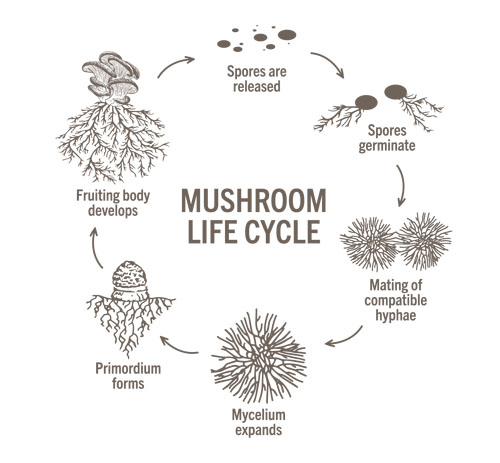For brands looking to harness the potential of functional mushrooms, there are some key issues to address when sourcing these ingredients. Recent debates have centred on the efficacy of different parts of the mushroom, such as the fruiting body versus the mycelium.
Although this is an important consideration when formulating a product, it’s only one of the factors to keep in mind when selecting a functional mushroom ingredient. To make more informed decisions, we must look at the bigger picture.
Kingdom fungi is vast and diverse
It has been estimated that the fungi kingdom comprises some 1.5 million species. This is only an estimate, however, as approximately 2000 species are classified every year and many fungi live hidden in the soil.
By comparison, Kingdom Plantae encompasses an estimated 300,000 species. These figures highlight the vast diversity that exists within fungi and the potential to discover new functional fungal ingredients.
Another factor that makes fungi so interesting is that, from an evolutionary perspective, they are closer to animals than plants.
Like us, they breathe oxygen and exhale carbon dioxide; like us, they are heterotrophic and eat other organisms for energy and nutrients.
This mutual ancestry means that we share a lot of the same cellular pathways and membrane receptors, which makes the potential for mushrooms to be a new source of functional ingredients more likely.
As a chemist, I always get excited about organisms such as mushrooms that have very little physical defence (no shells, spikes, spines, etc.) as they must use chemical protection to survive and, therefore, have very diverse and interesting chemistries. Mushrooms truly represent the next frontier of functional ingredient discovery.
Species: each is unique
When becoming familiar with functional mushrooms, it’s easy to assume that all mushrooms have very similar benefits; and, although they all contain beta-glucans, which can support immune health, each mushroom species has unique bioactive compounds that confer unique functional benefits.
This diversity is one of the most fascinating aspects of mycology. Each species possesses its own distinct set of characteristics and unique bioactive compounds, which can vary greatly in different strains of a single species and even because of differing cultivation methods.
Every day, mycologists are discovering more about these species and the nutrients and active compounds they contain. Science continues to advance as we uncover how to breed, grow and process these species and further demonstrate the potential functional benefits of each one.
Mushroom lifecycle and fungal parts: mycelium versus fruiting body

The mycelium – the longest living stage of the mushroom lifecycle — consists of a complex network of hyphae. This elaborate web penetrates the growing substrate — such as grain, wood or soil — breaking down organic matter and absorbing nutrients.
The mycelium is one cell layer thick and very porous. Therefore, it produces a lot of different molecules to protect itself from bacteria, viruses, insects, etc., and should not be overlooked as a functional ingredient.
Depending on the species, the bioactive compounds in the mycelium can be very different than those found in the fruiting body (by comparison, the chemistry of the mycelium and the fruiting body is very similar).
Mushroom spores are single-cell structures that act as the genesis of the mushroom lifecycle. Each spore contains the potential to develop into a network of mycelia.
Unlike plants that require pollination, mushrooms can produce billions of spores that disperse into the environment, demonstrating a remarkable capacity for propagation and survival. Understanding spore diversity, genetics and viability is essential when it comes to cultivating optimal strains consistently.
The fruiting body of a mushroom is the reproductive structure that emerges from the mycelium. This life stage typically includes structures such as the gills, cap and stem.
The fruiting body can in some cases have unique bioactive compounds compared with the mycelium as it is found above the substrate and exposed to sunlight.
The fruiting body can contain pigments that have antioxidant properties and other bioactive compounds meant to protect the fruiting body from life outside the substrate.
Full lifecycle mushroom product: leveraging the diversity
Utilising the whole mushroom, including both the mycelium and the fruiting body, provides access to the entire metabolomic potential of the organism. This “full-spectrum” approach offers a complex array of nutrients and bioactive compounds that work together to deliver comprehensive benefits.
The interplay of the various fungal parts allows for a holistic product that resonates well with consumers seeking the full potential of what mushrooms offer.
Cultivation: food safety, quality and efficacy implications
The cultivation of mushrooms is both an art and science that requires meticulous selection of the substrate, growing conditions and strains. A clean environment as well as carefully selected strains and substrates are some of the initial components and their importance cannot be overstated.
The substrate used in mushroom cultivation is not just the growing medium; it’s the primary source of nutrition for the developing fungi. Ideally, the growing substrate should be nutrient-rich and free from contaminants.
Controlled growing environment
Cultivation in a controlled environment allows for year-round growth and a consistent product. These methods offer significant advantages in terms of quality and uniformity. Variables in the environment — including temperature, airflow, carbon dioxide/oxygen levels and lighting — can be precisely controlled for each individual mushroom species.
These kinds of controlled environments ensure more predictable growth cycles and consistency in mushroom growth and health. Many aspects of mushroom growth can be monitored and adjusted to optimise the conditions for mycelium development and fruiting body production.
This precision not only ensures the provision of high-quality mushrooms but also minimises the risk of contamination from pollutants, pests and pathogens.
Mushrooms are bioaccumulators
Mushrooms are known to be bioaccumulators, meaning they have an amazing ability to absorb and concentrate substances from their surrounding environment. Certain species are even used to decontaminate polluted sites.
This characteristic makes it imperative to cultivate mushrooms in clean environments and to ensure that the air, water and substrates used are free from pollutants.
Organic versus conventional
The ability to certify that mushrooms are grown organically helps to ensure the purity and quality of both the growing environment and the end products. This year, the Strengthening Organic Enforcement (SOE) Rule, a new regulation put forth by the USDA National Organic Program (NOP), goes into effect.
This is the most significant change to the national organic regulations since the creation of the NOP and is partly designed to address issues of adulteration and fraud seen in the organic supply chain.
This new rule will help to level the playing field for domestic organic growers that follow NOP standards and those importing ingredients with less visibility to process flow and adherence to regulations.
Read Part II here.

